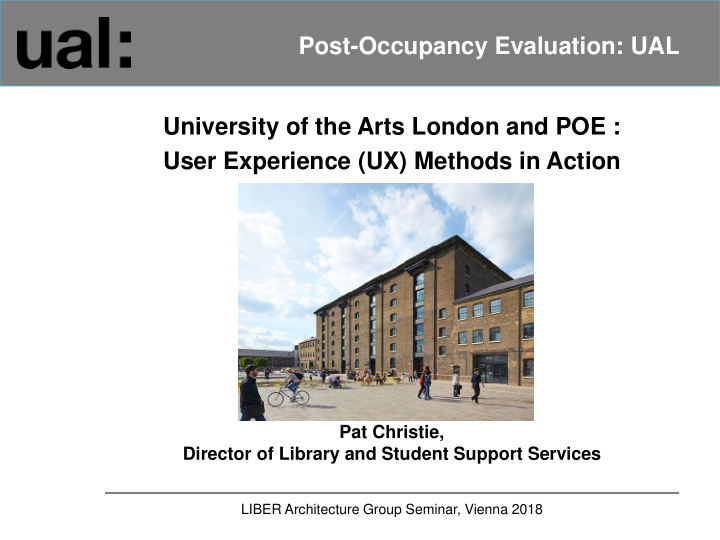



Post-Occupancy Evaluation: UAL University of the Arts London and POE : User Experience (UX) Methods in Action Pat Christie, Director of Library and Student Support Services LIBER Architecture Group Seminar, Vienna 2018
Post-Occupancy Evaluation: UAL University of the Arts London : a Global Creative Arts Community UAL is Europe’s largest specialist arts and design university It has c19,000 students from over 100 countries It provides courses from Foundation to Postgraduate level and is research-active It consists of 6 colleges: Camberwell College of Arts Central Saint Martins (CSM) Chelsea College of Arts London College of Communication London College of Fashion Wimbledon College of Arts LIBER Architecture Group Seminar, Vienna 2018
Post-Occupancy Evaluation: UAL Library Services at UAL : Six Colleges; One Service 6 College Libraries, 3 Learning Zones & University Archives and Special Collections Centre LIBER Architecture Group Seminar, Vienna 2018
Post-Occupancy Evaluation: UAL What Students told us during the Planning Phase for CSM Library LIBER Architecture Group Seminar, Vienna 2018
Post-Occupancy Evaluation: UAL Central Saint Martins Library, opened Autumn 2011 LIBER Architecture Group Seminar, Vienna 2018
Post-Occupancy Evaluation: UAL User Experience Methodology in the Academic Library UX methodologies apply ethnographic research techniques to the library context: “Ethnography is simply a way of studying cultures through observation, participation and other qualitative techniques with a view to better understanding the subject’s point of view and experience of the world” Andy Priestner, freelance trainer and consultant on user experience (2015) Excerpt from a student’s reflective diary produced as part of the UAL UX Library Project LIBER Architecture Group Seminar, Vienna 2018
Post-Occupancy Evaluation: UAL POE through the User Experience, 2015 : Project Objectives To compare student suggestions during planning with their feedback post-occupancy To observe learning styles and study behaviours within libraries and learning zones To optimise usage by responding to ways in which students make use of our spaces To understand students’ requirements better by encouraging students to tell us in their own words how and why they use our spaces To gather evidence on how we might improve existing spaces and to underpin library planning for new estates projects LIBER Architecture Group Seminar, Vienna 2018
Post-Occupancy Evaluation: UAL User Experience (UX) in Action, 2015 : Multiple Methods LIBER Architecture Group Seminar, Vienna 2018
Post-Occupancy Evaluation: UAL Lessons Learnt from UX Project : Design Successes Successes identified by students included: Library is seen as highly inspirational space (focus groups, touchstone tours + reflective diaries) The variety of study spaces combined with careful zoning is valued (touchstone tours + focus groups) Co-location of Library with Learning Zone has created a hybrid learning environment linking scholarly research with creative practice (static observations, focus groups + reflective diaries) Students see the library as a community hub and regard it as ‘their space’ (focus groups) Importance of views out of windows (static observations + touchstone tours) Coffee is indeed seen as a necessity (static observations)! LIBER Architecture Group Seminar, Vienna 2018
Post-Occupancy Evaluation: UAL Lessons Learnt from UX Project : Design Issues Issues identified by students included… Often over-crowded and can’t find books on shelves (movement mapping + touchstone tours) Layout and signage influence student behaviours and usage patterns (movement mapping + touchstone tours) More IT rather than less IT - BYOD is not enough (static observations + focus groups) Demand for more quiet and contemplative study spaces (focus groups + static observations) Environmental factors are key to personal comfort (focus groups + touchstone tours) Need for sufficient, robust and clearly signposted toilets (focus groups)! LIBER Architecture Group Seminar, Vienna 2018
Post-Occupancy Evaluation: UAL Additional Benefits of POE Lessons & the UX Project Students involved in UX Project became advocates for the Library in other ways UX was used as a case study for attaining Customer Services Excellence (CSE) and is now embedded within our responsiveness culture UX Reports used to prompt discussions with other stakeholders (academics etc.) Evidence gathered through UX supported business case for service developments incl. overnight opening Invaluable evidence base informing library designs within 3 new estates projects LIBER Architecture Group Seminar, Vienna 2018
Post-Occupancy Evaluation: UAL Final Reflections and Q&A Importance of closing the feedback loop and implementing improvements in response to the feedback, no matter how small Buildings and learning behaviours constantly change so evaluation of library spaces needs to be continuous and through multiple methods Our expertise in UX methodology now means that we can use UX in other projects, such as our Review of the Library’s Digital Presence (cognitive mapping) Importance of library staff feedback too! LIBER Architecture Group Seminar, Vienna 2018
Recommend
More recommend